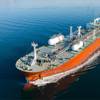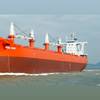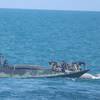South Korean shipyards are expected to win about 75 percent of an estimated 48 orders for liquefied natural gas (LNG) carriers this year, industry officials said on Wednesday.
"There are virtually no rivals to compete with Korean shipbuilders in making LNG carriers in terms of price and quality," said Yoo Jae-won, a spokesman for the Korea Shipbuilders' Association.
Surging demand for environmentally friendly LNG was expected to raise the number of LNG carrier orders to around 48 this year from only 14 last year.
"Korean shipbuilders are poised and look likely to grab most of the orders," Yoo said.
Daewoo Shipbuilding and Marine Engineering, the world's second-ranked yard, said its LNG orders totalled 10 ships worth $1.7 billion so far this year, with options for 12 more.
"We expect to secure 8-10 more LNG ships from the options for the rest of this year," said Daewoo spokesman Kim Do-kyun. "Given our capacity limit, we can't accept more."
Top shipbuilder Hyundai Heavy said it had secured orders for six LNG carriers so far this year and was expecting to get two to four more.
Meanwhile, Samsung Heavy has won orders to build six LNG carriers with nine options, of which two were expected to be signed this year.
Japanese shipyards had received orders for eight LNG ships but their total orders for this year were unlikely to exceed 10 LNG carriers, officials said.
Spanish shipbuilder IZAR was the only European yard to win LNG orders with two ships, they said.
"Japanese and European shipbuilders can't really make reasonable profit on LNG orders because their facilities and manpower are not as good as those of the Koreans," said Lee Jong-seung, analyst at Daewoo Securities. "They could get orders from their home customers."
Analysts said an LNG carrier order priced around $170 million would provide a profit margin of about 20 percent for Korean shipbuilders.
They said Korean shipyards have benefited from an efficient and well-trained workforce, while Europe and Japan have suffered because educated workers have shifted towards white-collar jobs.
In addition, the won's sharp decline against the dollar following the Asian financial crisis in 1997, has equipped Korean yards with tremendous export price competitiveness.
The exchange rate, which stood at around 1,284 won per dollar on Wednesday, had been nearly 2000 in late 1997 from a pre-crisis level of about 800.
South Korea's relatively late entry into the shipbuilding industry has also helped because its newer yards offer greater efficiency than those of its older rivals in Japan and Europe.
Daewoo Shipbuilding, which has garnered orders for six LNG carriers in 2000, also has an edge in the LNG carrier market as its membrane-type model has emerged as a favorite over the moss-type carrier.
Unlike the moss-type models, where globe shaped gas tanks interfere with the sight of crew members, the membrane-type vessel looks like an ordinary bulk carrier. -- (Reuters)
Featured videos

Inmarsat Enhances Service to Drive Digitalization

Unlock Onboard Data Efficiencies

Tracking Foreign Vessels Working in the U.S. Jones Act Market
Subscribe for
Maritime Reporter E-News
Maritime Reporter E-News is the maritime industry's largest circulation and most authoritative ENews Service, delivered to your Email five times per week









